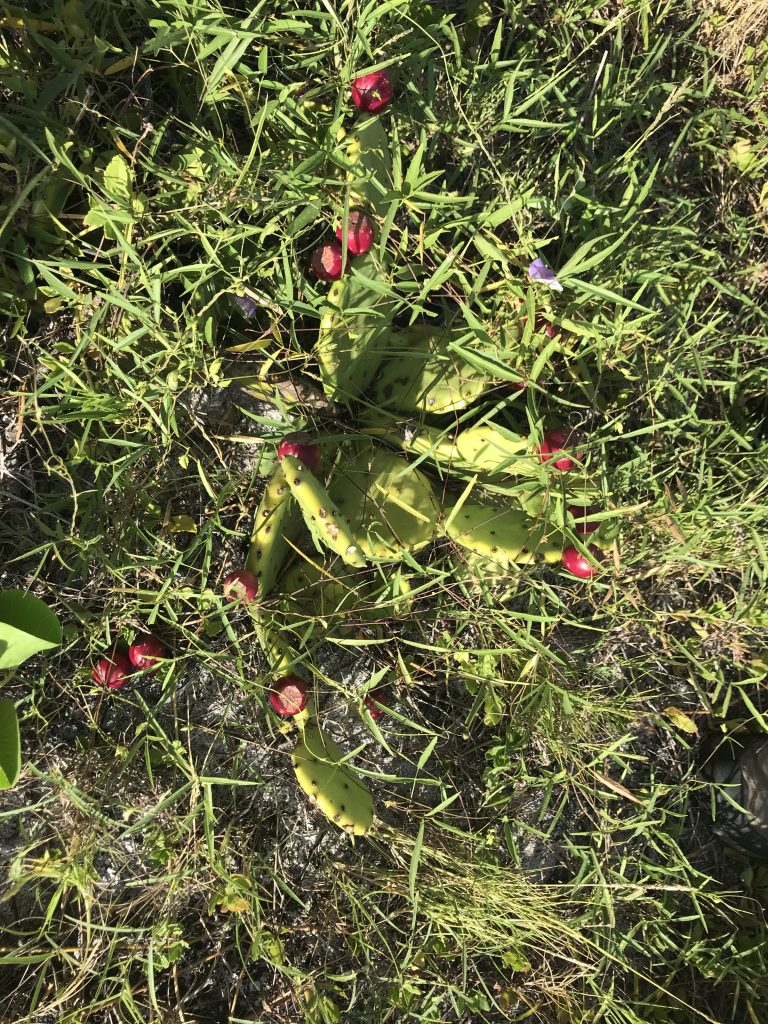
Opuntia tunas do turn red when ripe. These at Ft. Desoto went a shade further. The taste varies from raspberrry to tomato-like. The hard seeds are buttery and edible if cooked and or ground. The pads are also edible minus glochids. Photo by Green Deane
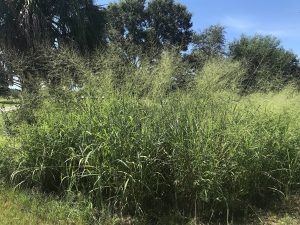
Panic Grass has been local Livestock food since 1933. Photo by Green Deane
Panic grass is an edible non-native grass. You can collect the seeds nearly all year. Unlike most non-native grasses it does not have cyanide. You can also dry the blades and powder them to extend flour or to add bulk to soup and stews. After a lot of rain make sure the seeds and not discolored or swollen with fungus. The species was moved out of the genus Panicum to Megathyrsus in 2003. Considered an invasive in south Texas and Hawaii, it was a popular forage for livestock because it is a “cut and carry” grass, an easy one to collect and take back to your animals. The origin meaning of the word “foraging” is collecting food for your animals. The Romans later applied it to their raiding the countryside for food for themselves.
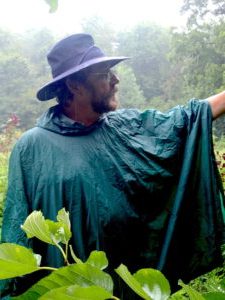
Classes are held rain or shine (but not during hurricanes.) Photo by Kelly Fagan
FORAGING CLASSES: The best meterological guess for this weekend is a huge amount of rain both days. Cassadaga is hilly so our feet should stay dry and Mead Gardens has places to duck in should the rain get very heavy.
Saturday September 10th, Colby-Alderman Park: 1099 Massachusetts Street, Cassadaga. Fla. 32706. 9 a.m. meet at the bathrooms
Sunday September 11th. Mead Garden: 1500 S. Denning Dr., Winter Park, FL 32789. Meet at the bathrooms 9 a.m.
For more information, to pre-pay, or to sign up of a class go here.
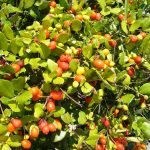
Simpson stopper is a common landscape shrub.
Sea gapes are a protected species locally because they hold dunes in place — same with sea oats — that did not stop us from eating many mostly off the beach this past Saturday. They have a unique pleasing flavor. A test gallon of wine I started from them last year is not yet ready for tasting. We also nibbled on a lot of Simpson Stopper berries Sunday in Largo. It was easy to taste how they were made into jelly a century ago. They have a marmalade-like flavor, bear heavily for several weeks and are easy to work with. We also found a lot of end-of-season seablite, a species that should become a commercial crop.

You get the USB, not the key.
Changing foraging videos: As my WordPress pages are being updated the video set will go away. They are the same videos I have on You Tube. Some people like to have a separate copy. The DVD format, however, is becoming outdated. Those 135 videos plus 36 more are now available on a USB drive. While the videos were played from the DVDs the videos on the USB have to be copied to your computer to play. They are MP4 files. The 171-video USB is $99. If you make a $99 “donation” using the link at the bottom of this page or here, that order form provides me with your address, the amount — $99 — tells me it is not a donation and is for the USB.

Green Deane Forum
Want to identify a plant? Perhaps you’re looking for a foraging reference? You might have a UFO, an Unidentified Flowering Object, you want identified. On the Green Deane Forum we — including Green Deane and others from around the world — chat about foraging all year. And it’s not just about warm-weather plants or just North American flora. Many nations share common weeds so there’s a lot to talk. There’s also more than weeds. The reference section has information for foraging around the world. There are also articles on food preservation, and forgotten skills from making bows to fermenting food.
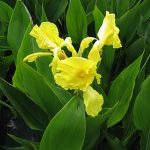 When it comes to plants you can see something for a long time but not see it. That was my experience with Canna. In the late 80’s a friend of mine had Canna planted along her house. As she was from Taiwan I presumed — like most of the plants around her home — they were native to Asia. As it turned out I was just one in a very long line of people thinking this native of the Americas was Asian. I didn’t make the connection to local Canna because the two species have different blossoms, one skinny and red, the other fat and yellow. But then one day while fishing along the St. Johns River east of Sanford I saw a large stand of “native” Canna and investigated. There are several edible parts to the Canna including the roots. The hard seeds, however, have been used as a substitute for buckshot… they are that hard. You can read more about this peripatetic beauty here.
When it comes to plants you can see something for a long time but not see it. That was my experience with Canna. In the late 80’s a friend of mine had Canna planted along her house. As she was from Taiwan I presumed — like most of the plants around her home — they were native to Asia. As it turned out I was just one in a very long line of people thinking this native of the Americas was Asian. I didn’t make the connection to local Canna because the two species have different blossoms, one skinny and red, the other fat and yellow. But then one day while fishing along the St. Johns River east of Sanford I saw a large stand of “native” Canna and investigated. There are several edible parts to the Canna including the roots. The hard seeds, however, have been used as a substitute for buckshot… they are that hard. You can read more about this peripatetic beauty here.
In the olden BC days... before computers… Labor Day meant you went back to school the next day. School also let out sometime in June. Your release date was never exact because several “snow days” were built into the calendar every year. If they weren’t used up we were parolled in early June. If it was a bad winter then we got out mid-June. We also were not too far removed from harvest time on both ends of the school sentence.
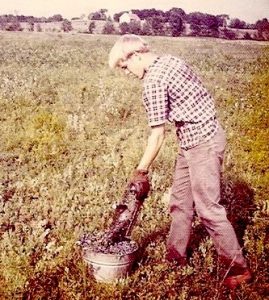
Harold Grandholm, a high school classmate, raking blueberries off the road I grew up on during “summer vacation” in Pownal Maine
I walked to school daily, five miles round trip, and that was my preference. The wander took me past blueberry fields, Concord grape hedgerows, apple orchards and a great view of New Hampshire’s Mt. Washington some 60 miles away. I was scrumping every morning and afternoon for six weeks or so. This daily Too & Fro also included crossing the Royal River which was really more of a serf stream except during the spring floods. (I fished and fell into the Royal a lot. Found my first black pearl there and caught my first eel there, impressively several dams upstream from Casco Bay.) All that wild fall fruit always ruined my supper but then again my mother was a horrible cook so it worked out well. In September and October you also sized up last year’s now dry fire wood. We had two wood stoves, one for heat and one for cooking. And once there was snow on the ground that meant “pulping season” which is cutting next year’s firewood so it can “season” (dry) for a year. Plants were also part of school letting out in spring. I noticed way back in sixth grade that when the (edible) Lilacs blossomed school was nearly out for the summer… and summer vacations were wrongly named: For most kids where I grew up it meant farm work until school started in September. For me it was three full months of working in the hay fields, a hot, dusty, hornet-punctuated job. My mother collected horses (and other farm animals) and they had to be fed so into the fields I went, indentured labor. There was also summer gardening, 70 days of it. I only escaped all that by volunteering for the Army in 1969 when Vietnam was hot… young men can make stupid decisions… but I never hayed again. Now my daily routine includes the volunteer feeding of goats, sheep, pigs, cows, ducks, chickens, turkeys, and guinea fowl… no horses by chance though I might find a pet donkey.
This is weekly newsletter #522. If you want to subscribe to this free newsletter you can find the sign-up form in the menu at the top of the page.
To donate to the Green Deane Newsletter click here.

